How does the automation of a gas boiler work? Safety automation for hot water boilers
As you know, gas heating appliances are equipment that can create an emergency situation involving a fatal risk. Accidental flame extinguishing or gas leakage can lead to explosion or suffocation, and overheating of the boiler can lead to best case scenario, to its breakdown. Functional safety automation for gas boilers will be able to prevent risks at an early stage. In addition, it promotes more economical consumption of fuel resources and increases the level of comfort during operation of the heating system as a whole. The cost of an automation unit depends on the number and complexity of options included in the circuit. Some of them are mandatory, and therefore must be present in every gas boiler without exception.
Operating principle of basic automation
Modern heating equipment is certainly equipped with a security system and control units with the function of regulating operating modes. An element of basic automation is an electric or piezo ignition, which supplies a spark to the igniter at the moment the gas supply begins. To start the combustion process, you just need to press the button located on the body of the heating boiler.Next, the machine turns on the gas burner, which picks up the fire from the igniter. After the coolant has warmed up to the required temperature, the automation (in this case the thermostat) switches off the burner, and when the water cools down to the limit values, a signal is given to turn it on. The igniter continues to burn all this time. This option allows you to:
- protect the surrounding area from possible gas leaks;
- prevent water from boiling in the heat exchanger;
- stop supplying fuel to the nozzle if there is no draft or a sudden change in gas pressure in the main pipeline.
Maintaining optimal boiler operation and equipment safety have long depended not on human factor, but from the automation that comes with gas equipment. It can be volatile, more reliable, but requiring the presence of an uninterruptible power supply, and non-volatile (mechanical), characterized by autonomy and simple design. The security system can only consist of necessary elements or be multifunctional, have manual control or a programmer.
Automation ensures reliable and economical operation gas boiler without human intervention.

Non-volatile system
Such automation is attractive due to its isolation from electricity, low cost and maintainability. The operating temperature range that affects the operation of the thermostat is set here manually using a switch connected to the thermostat built into the boiler. Its design contains a rod made of a material that can shorten and lengthen as the temperature of the coolant changes. As a result, the gas supply valve opens or closes, completely cutting off the flow of fuel to the burner.
Included non-volatile automation also include flame and draft sensors. If the burner suddenly extinguishes, as well as with a significant decrease in draft, the gas is instantly shut off. But for comfortable and economical operation of modern boilers, the above options are not enough. Manual regulation does not make it possible to use the equipment in optimal modes, so savings, comfort and service life of the boiler without additional automation are reduced to a minimum.
Volatile system
Maximum ease of use of gas heating devices provided by electronic automation. You just need to enter operating parameters or already programmed modes on the display, and the regulation and control system comes into play. It operates based on the principle of solenoid valves receiving commands from a microprocessor unit.
The disadvantage of volatile automation is its dependence on electricity. In the event of possible failures in the electrical network, the equipment is blocked and the coolant stops warming up, which leads to cooling of the heating circuit. The functionality of the system and boiler safety elements is maintained by connecting the equipment to an uninterruptible power supply or to a diesel generator.

Modern automation is capable of:
- support different temperatures depending on the days of the week or time of day;
- regulate the thermal regime, taking into account weather conditions;
- create individual temperatures in individual rooms;
- prevent freezing of the heating circuit;
- diagnose faults and much more.
Automation system components
Automatic control elements are divided into several groups, depending on their functional purpose and design features. When purchasing a boiler, you need to familiarize yourself in more detail with the set of options presented, because the price of a gas boiler depends on their quantity. It is possible that overly complex components are not required. Why then overpay?
Automation for heating boilers includes:
- thermostats;
- valves;
- relay;
- sensors;
- controllers.
Thermostats are considered one of the simplest electromechanical devices in an automation system. Their functions include ensuring the specified temperature regime coolant and sending a signal to turn on or off gas burner after reaching threshold or boundary values.
Thermostats prevent water from boiling or freezing in the boiler.
The valves regulate the gas supply to the burner. More precisely, they block or open the nozzle of the supply pipe.

The coolant pressure switch in the system protects the gas boiler from serious damage. The fact is that too low pressure causes airing, boiling and stopping the circulation of water in heating circuit. The result is severe overheating of the boiler. Excessive pressure is no less dangerous, as it leads to an emergency and can provoke an explosion. In the first case, the situation is controlled by a minimum pressure switch, and in the second - by a maximum pressure switch.
Relay devices also monitor gas pressure. Normal operation The burner is assumed to be at nominal pressure, so when it decreases or increases, emergency situations occur. In the first case, the flame begins to “settle” in the burner, which leads to burnout of the pipes. In the second case, it rises too high, as a result of which the combustion chamber suffers. Depending on the circumstances, the minimum or maximum gas pressure switch turns off the boiler in order to protect the equipment from serious damage.
Sensors that detect the presence of coolant in the heating system are an important addition to the boiler. They do not allow the equipment to be turned on without filling the circuit, which prevents the occurrence of emergency situations. The sensor is made in the form of a float or electrodes placed in the hydraulic circuit in a certain way.
Controllers are electronic devices that control individual components or the heating system as a whole. In this case, both internal factors affecting the operation of the gas boiler and external conditions, including weather. Controllers can have different capabilities and have different functionality. They are classified according to several positions:
- integration scheme with boiler equipment;
- management algorithms;
- set of capabilities;
- direction of service.
Available for gas boilers big choice automation, allowing safe and comfortable use heating systems. When purchasing equipment, you should familiarize yourself in detail with the options offered by the manufacturer. Being mindful will help you avoid surprises.
Compliance with the operating regime of household boilers, regardless of the type of fuel on which they operate, is very important. The longevity of use of the equipment and the safety of people who use this equipment depend on this.
Gas automation for boilers makes it possible to comply with all technical requirements for optimal operation of the equipment. It completely relieves the user of the need to control the operation of the boiler. Automation continuously monitors the heating and hot water supply process so that an ideal microclimate is maintained in the apartment or house. Today it is difficult to imagine a modern water heating boiler without it, and that is why the vast majority of manufacturers use it in the process of creating heating equipment.
Automation for a gas boiler is divided into two main types:
- Non-volatile mechanical structures. They are simple, but at the same time demonstrate high efficiency. Such automation responds to changes in water temperature in the system.
- Volatile electronic devices. This is equipment that operates from an external energy source, be it a network or a generator. This group includes a lot innovative developments, designed to make the boiler your everyday assistant.
Let's look at each of these groups separately.
Mechanical automation
Mechanical automation has a number of advantages. Firstly, this equipment, as already mentioned, is characterized by its simplicity of design. Because of this, it is very reliable and practically does not break. And in case of failure, mechanical automation can be easily repaired or replaced with a new one without significant losses for the family budget.
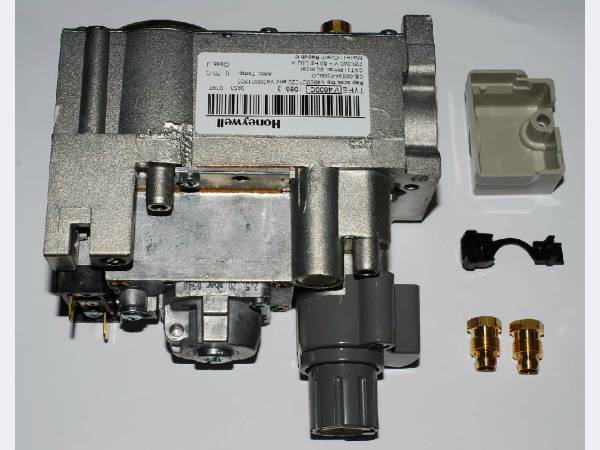
Secondly, such automation is inexpensive, which affects the cost of the boiler. It is autonomous in use, since it does not require external power sources to operate.
Mechanical automation for a gas boiler is configured manually. The specialist sets the coolant temperature range. Such automation works on a simple principle. The temperature regulator starts working immediately after ignition and responds to changes in coolant parameters. If the water temperature in the system drops, the automation opens an additional gas supply to the main burner.
The design of the thermostat implies the presence of a rod made of special material, which responds to a decrease or increase in coolant temperature. In the process of changing the parameters of the coolant, the thermostat lengthens or shortens, while regulating the gas supply to the main burner.
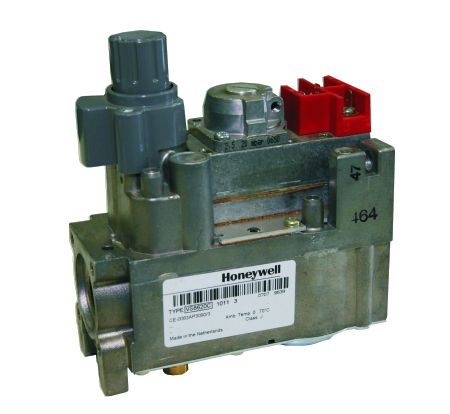
Often included mechanical automation there is a draft and flame sensor. These units are very important for the safe operation of the boiler. They turn off the gas supply if the burner flame goes out or the draft level decreases. Such sensors are often bimetallic plates that change their shape under the influence of temperature, thereby regulating the fuel supply in the system.
Electronic automation
Electronic automation for a gas boiler is distinguished by the complexity of its designs and the variety of functions performed, among which the following are worth noting:
- Creation safe conditions for the operation of heating equipment;
- Security maximum comfort in a heated room;
- Raising the coefficient useful action systems;
- Improved environmental performance;
- Programming the boiler operation depending on the time of day or day of the week;
- Weather-dependent regulation of boiler operation;
- Automation of control various contours heating system;
- Heating of coolant for domestic needs.
All modern electronic devices operate on the principle of a solenoid valve, which is controlled by a microprocessor unit. Boilers with such gas automation are equipped with a special display, with the help of which one or another mode is selected. Compliance with the conditions specified by the user will be “monitored” gas automatics for boilers.
The standard list of functions that such equipment performs is as follows:
- Automatic boiler start;
- Burner power control based on information provided by built-in sensors;
- Stopping equipment;
- Emergency stop of equipment in case of detection of a certain problem.
In addition, some manufacturers, in an effort to expand the functionality of the equipment they offer, equip it with an antifreeze system, protection against pump jamming and three way valve, fault diagnosis system and pump overrun. Among the most common components electronic automation an electronic controller, relay should be allocated for a gas boiler gas pressure, gas fittings, valves, and display. In some cases, advanced equipment is equipped with a pressure switch and a water level sensor.
Results
Non-volatile boilers are not as expensive as units equipped with electronics. That is why potential buyer before making the final choice, you need to decide what he expects from a gas boiler. If you nevertheless decide to purchase a volatile unit that can give you maximum comfort, then make sure that you can provide the boiler with uninterruptible power supply from the network or from a generator. Otherwise, the equipment simply will not be able to continuously perform its assigned functions.
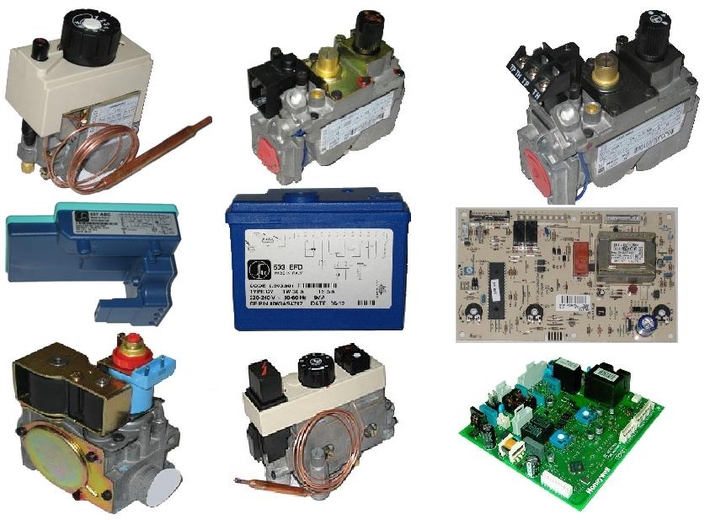
Today, many users have brought the system into their homes. individual heating. It gives many undeniable advantages over centralized heating. The user will be able to independently set all the desired operating parameters and control the indoor temperature level. For this purpose, we use automation for gas boilers, which allows you to set flexible settings and change them at any time depending on the situation. The product also increases the reliability of the heating system.
Possibilities of an electronic heating system
In addition to significant expansion functionality boiler, safety is also increased due to automation. The electronic control system has many monitoring sensors, which in the event of emergency situations will stop the gas leak and notify the user of an error. The possibility of emergency shutdown without human intervention will avoid any consequences. You just need to call a specialist or carry out diagnostics yourself.
Majority modern products are equipped with a control device at the factory. This allows you to ideally select all operating parameters and enter them into the basic settings. The user will then only have to choose the mode that is most convenient for him. But gas automation for an old boiler will require self-installation. And here the main thing is not to make a mistake technical specifications existing device.
In principle, the devices have high degree universality, but it cannot be said that they are suitable for any product. Yes and a large number of manufacturers also requires detailed study. For example, Italian automation for a gas boiler or SABC cannot be compared. But the domestic model can be easily installed on any old boiler, but with imported analogue you'll have to tinker a lot.
Some trading companies give users the opportunity to assemble their own boiler from existing components. In this case, you need to find the most optimal option from an economic point of view. It is also important that the control unit can reveal the potential of the boiler. For example, when choosing for Zhukovsky gas boilers Honeywell automation, you could be wasting your money. All the same, the technical capabilities of the heater will be very limited, and most functions will remain unclaimed. This leads to large financial losses.
Design and principle of operation of the system
The automation device for a gas heating boiler and its diagram can be studied below:
- 1. Initially, the gas passes through the purification filter and enters the solenoid valve, which regulates the fuel supply to the burner.
- 2. Near the valve there are temperature and draft sensors, which ensure that all operating indicators are within the established limits.
- 3. The thermostat with bellows and rod is used to set the desired temperature parameters. For this purpose, there is a special control button on the block.
- 4. The multi-level control system reads information from all sensors and, depending on the data received, makes a decision on the further operation of the boiler.
![]()
The operating principle of automation is based on the laws of physics. When the heat exchanger cools down 10-15 degrees below the set temperature, the gas supply sensor is triggered and the burner begins to intensively heat the water. When the required level is reached, automatic shutdown in order to save fuel. All data is transmitted in the form of electromagnetic pulses, which do not interfere with other equipment and do not harm humans and pets.
After installing the boiler, it is necessary to adjust and configure its automation. This can be done by the technician who installed the heater, and without additional payment. But if desired, the client can refuse the service and take matters into his own hands. To cope with this task, it will be enough to read the instruction manual, which describes the procedure in great detail. For clarity, you can look at pictures or find a video on the Internet.
Features of repair and replacement
Repairing automatic faults in household gas boilers is quite challenging task. It will be necessary to diagnose and check each element of the system to identify problem area. Malfunctions are most often associated with filter contamination or sensor burnout due to sudden voltage surges. Cleaning should be entrusted to a professional, because inept manipulations can lead to further big problems, and then you will need to buy a new unit. But install new ones electronic elements possible without outside help.
Replacement of the gas boiler automation unit is carried out only in the most extreme case, when it is impossible to repair the device. It is almost impossible to bring the device to such a state, so more often the unit is changed simply because of low functional equipment and a more structurally advanced accessory is installed.
This is often done when purchasing domestic heaters. The standard automatic equipment is removed, and an imported one is installed in its place. But it must be taken into account that perhaps not all functions will work due to the design features of the boiler itself.
The price of automation for gas boilers Concord and Lemax will be 3-5 thousand rubles. For other models, the value will be approximately the same, but it is better to find out the current cost from official dealers.
For the automation of DKVR, DE boilers that operate on gas/fuel oil and TVG, KV-G boilers that operate on natural gas, use automatic control kits based on the Kontur system, safety and control automation in a switchboard type Shch-K2 (Shch-K2U).
The Kontur system was mastered by the Moscow Thermal Automation Plant (MZTA) in 1978. Until that time, MZTA had produced the Kristall electronic-hydraulic system.
Rice. 28. Front panel of instruments of the “Kontur” system.
Automatic control "Contour" (see Fig. 29) designed to regulate parameters technological process boiler units.
Every automatic regulator It has:
1. Sensor (primary device).
2. Regulating device (amplifier).
Z. Actuator mechanism.
4. Regulatory authority.

D is a sensor that reacts to a change in the measured parameter and converts the change in the parameter into an electrical signal. The sensor consists of a measuring and electrical transducer.
The measuring transducer can be an elastic membrane, a manometric tube, etc.
The electrical converter consists of a differential transformer coil and a steel core.
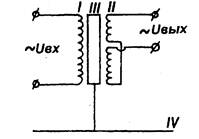
I - primary winding of the differential transformer coil;
II - secondary winding of the differential transformer coil;
III - steel core;
IV - elastic membrane of the measuring transducer.

Rice. 29. Diagram of the automatic control system "Kontur" on steam boilers type DVKR.
The sensor receives power »Uin = 12 (24) V from its control device P.25. U out changes its value depending on the position of the steel core III.
R.25 - a regulating device with a setpoint. It supplies power to its sensor, from which an electrical signal U out is received, which is compared with a given one, and if these signals are unequal, an amplified electrical signal appears at the output of P.25, which turns on the actuating mechanism.
IM - actuator - can be hydraulic type GIM and electric type MEO (electric unirotational mechanism).
It moves the regulator.
RO is the regulatory body. Depending on the parameters that are regulated, it can be: a control damper (RZ), a blower fan guide vane (ADV), a smoke exhauster guide vane (ADV), a control valve (RK).
Regulators are installed on steam boilers:
1 - Steam pressure regulator in the boiler drum.
2 - Gas-air ratio regulator.
3 - Vacuum regulator in the furnace.
4 - Water level regulator in the boiler drum.
Automatic boiler protection is designed to shut off the fuel supply to the boiler burners if the safety parameters deviate beyond acceptable limits.
According to the parameters of the vacuum in the furnace and the water level in the drum, the fuel supply is turned off with a time delay of 15-20 sec. This eliminates the influence of short-term changes in vacuum and level, which cannot cause a boiler failure.
When the protection system is in the on state, the sensor contacts that monitor the parameters included in the circuit are closed. The corresponding intermediate relays and the electromagnet that controls the shut-off valve are energized. The fuel shut-off valve is open. The protection system remains in this state as long as the parameters included in it are within normal limits.
If one of the parameters deviates beyond the permissible limits, the contact of the corresponding sensor opens, the current disappears on the intermediate relay and the electromagnet that controls the fuel shut-off valve. Shutting off the fuel supply is accompanied by the lighting of the shutdown reason and “Boiler off” display, then the sound alarm turns on.
The protection control elements include six light displays of the TSV type (two-lamp), installed in the upper part of the front panel of the Shch-K2 (Shch-K2U) automation panel. When switched on, the display does not light up, and when the protection is triggered, the lamps of only one display light up, which indicates the reason for the operation, as well as the lamps of the “Boiler off” display.
The shut-off valve is opened using the valve levers installed on the gas pipeline in front of the boiler.
The protection controls on the Shch-K2 (Shch-K2U) panel include a boiler switch, a fuel switch, and a photosensor switch.
The boiler switch handle has four fixed positions:
1) vertical - protection is turned off;
2) 90° from the vertical clockwise - preliminary switching on (ignition of igniters);
3) 135° clockwise - the protection is fully turned on (set to standby);
4) 45° from vertical counterclockwise - protection is previously disabled.
The fuel switch handle has two fixed positions:
a) vertical - the boiler runs on fuel oil;
b) horizontal (90° counterclockwise) - the boiler runs on gas.
The photo sensor switch handle has two fixed positions:
a) vertical - the torch of the left burner is controlled;
b) 45° from the vertical counterclockwise - the torch of the right burner is controlled.
Technological protection includes:
Boiler safety automation;
Process alarm;
Automatic flame control automatic transmission.
Automatic safety sensors:
1. Gas pressure - sensor type DN or DD.
2. Air pressure - DN type sensor.
3. Vacuum in the furnace - DNT type sensor.
4. Presence of flame - electronic flame control unit with a photocell or control electrode.
5. Steam pressure - ECM (electric pressure gauge).
6. The water level in the drum can be controlled:
a) using electrodes placed in a uniform column, which is connected to the boiler drum;
b) using a level column and a differential pressure gauge-level gauge with setpoints.
The operation of the automatic safety system should lead to shutting off the fuel supply to the burners when the controlled parameters are turned off beyond the permissible values.
Considering that emergency modes most often arise due to incorrect actions of maintenance personnel when starting the boiler, the automatic safety circuit includes remote and automatic ignition as a component, during which the following must be ensured:
1. Control over correct execution pre-launch operations.
3. Filling the boiler with water.
4. Control over normal condition parameters at start-up.
5. Remote ignition of the igniter from the control panel.
For steam boilers Regardless of steam pressure and performance, devices must be installed that will automatically turn off the fuel supply to the heaters when:
1 - increase or decrease in fuel pressure in front of the burners;
2 - decreasing air pressure in front of burners with forced air supply;
3 - lowering the vacuum in the furnace;
4 - extinguishing the burner torch;
5 - increasing steam pressure above the working one;
6 - increase or decrease in the water level in the boiler drum beyond acceptable limits;
7 - malfunction of protection units, including loss of voltage.
The “Contour” automation system is turned on in the following sequence:
1. Prepare the boiler for ignition in accordance with the production instructions.
2. Make sure that the supply voltage is supplied to the Shch-K2 (Shch-K2U) shield.
3. The instrumentation and automation mechanic should check the installation of the necessary protection inserts:
a) the required water level in the drum;
b) the required vacuum in the press;
c) normal air pressure in front of the burners. After this, the corresponding signal board on the front panel of the shield goes out. When only the “Boiler off”, “No torch” and “Low gas pressure” displays remain lit, you must:
4. Return the boiler switch knob on the Shch-K2 (Shch-K2U) panel to the “Preliminarily switched on” position. When the handle is in this position, the igniter turns on and the “No torch” signal board goes out.
5. After the pilot light appears, cock the shut-off valve levers (open the gas passage).
6. Light each burner by manually opening the taps (valves) in front of the burners. Set the gas pressure to the burners according to the regime map (30% - no load).
7. Adjust the air supply and vacuum in the furnace.
8. After ignition of the burners with a time delay, it is turned off using the pilot light.
9. Set the boiler switch knob to the “On” position. We set the boiler protection to standby condition.
10. When the pressure in the boiler reaches operating pressure, connect the boiler to the general boiler steam manifold.
11. Make an entry in the shift log about ignition of the boiler, indicating the time.
The planned shutdown of the boiler is carried out by smoothly changing one of the parameters included in the protection system. When this parameter goes beyond the permissible limits, the protection is triggered and the boiler stops. At the same time, the operation of the protection is checked.
After turning off the boiler using the shut-off valve, close the “control” and “working” valves (valves) in front of the burners and open the purge “candles” between them. Close the valve on the gas pipeline in front of the boiler, opening the “candle” on the gas manifold of the boiler.
Close the main steam valve on the boiler and disconnect it from the main steam manifold. When the pressure in the boiler rises, release it through safety valve. Maintain the water level in the drum within the highest operating level in the boiler.
Make an entry in the shift log indicating the time the boiler stopped.
This definition includes all executive and control devices, designed to maintain the required operating modes of boilers and carry out measures to ensure their safe operation with minimal human involvement for these purposes.
Automation for the boiler control is divided into two large groups: independent and dependent on external power supply.
To a very first approximation, automation, which forms the basis of the control systems of any boiler, is a certain set of tools used to exert a certain influence on it and on the heating system as a whole.
Types of equipment for automatic gas boilers
On almost all types of boilers currently offered by manufacturers and trade organizations, there is automatic heating control varying degrees complexity, which allows you to operate boilers without direct participation in this process person.
The available systems allow: to ensure safe operation of boilers; automatically turn them on and off as needed; manage certain parameters (time, assessment of external weather conditions, etc.).
All available automation for a heating boiler is divided into a number of elements used for its classification: its functional purpose, device or type.
- Fittings. This is an actuator that executes commands to control the boiler (stopping and starting the boiler, adjusting power). The main purpose is to ensure safe operation;
- Valves. If the boiler has a built-in burner, then a valve must be installed on the fuel supply line to it, allowing or cutting off its supply;
- Minimum pressure switch (for gas boilers). The main function is to protect the burner and boiler from damage when the pressure under which the fuel is supplied drops. If the pressure is below the minimum allowed (set during commissioning of the boiler), the relay turns it off. When the pressure in the line is restored to the permitted value, the relay forms a circuit that allows the boiler to start again.
- Maximum pressure switch (for gas boilers). The function is similar to the previous relay. But only with an uncontrolled increase in pressure on the burners.
- Thermostat. The main task is to maintain the set temperature parameters of the coolant. It is technically possible to determine threshold limits (max/min) of temperature.
- Controller. An electronic device that differs in communication capabilities, degree of integration with the boiler, object and control algorithm, etc. in each specific case it is designed to perform a certain range of tasks.
- Coolant presence sensor. Protects boilers from operating without coolant in the heating system lines. The most commonly used sensor is a conductivity sensor or reed switch.
- Boiler priority relay. It is used in cases where a boiler is also connected to the boiler control circuit (it is set to priority heating, as it prepares water for everyday needs).
There is also automation for gas heating boilers, which belongs to the safety group.
This includes, first of all, relays set to minimum and maximum pressure coolant used in the system, and turning off the boiler when they are reached.
For them, as a rule, both automatic and manual restart are structurally provided.
Features of using devices for boiler automation
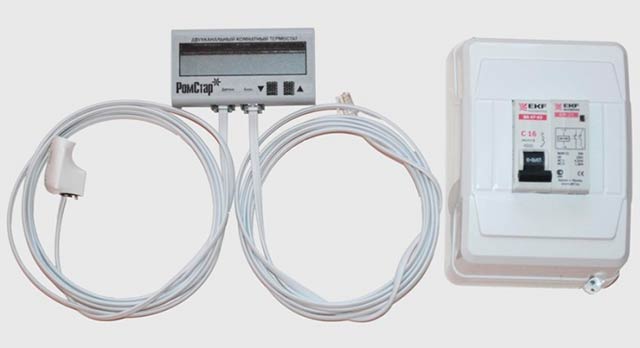
Features of the use of one or another type of device are dictated by the design of the boiler. At the most simple designs(gas non-volatile), control – manual. The only instrumentation items are a pressure gauge and a thermometer, as well as a piezoelectric element for ignition.
The next stage is occupied by boilers with an electronic control board. Such automation for heating a private house performs the following functions:
- controls the actual temperature of the coolant and can turn off the boiler if it overheats;
- controls the concentration of combustion products at the boiler installation site and turns it off when this parameter increases.
The latest models have added the function of connecting a pump, which is controlled by the boiler automation. This, albeit primitive, is already a multifunctional heating control system (MCS).
The third group consists of boilers that have built-in automation. When determining whether the boiler belongs to the specified group, do not confuse the elements: controller and control board.
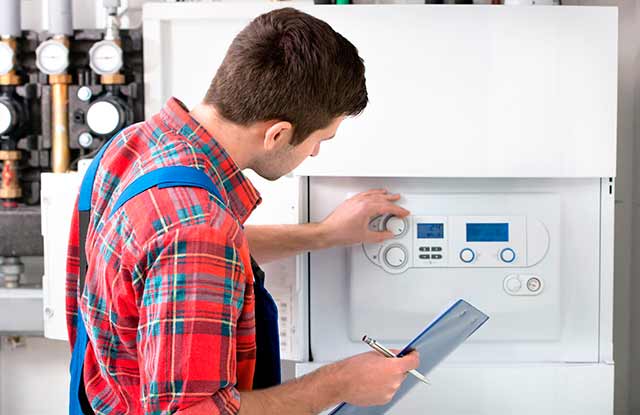
If the latter is tied to regulating the operation of one boiler, then the first controls the entire complex of control system equipment, taking into account external parameters: temperature (outdoors and indoors), the required temperature of the water prepared by the boiler for household needs, etc.
Built-in automation for gas heating boilers has enormous potential.
Without direct human participation, she independently sets the boiler operating parameters that provide the most comfortable conditions in heated rooms.
Such automation is usually called weather-dependent. It can react proactively to any changes in external temperatures.
In conjunction with external controllers, the automation of such boilers allows you to control external systems(cascade of heating solar panels or a pool heat exchanger, for example).
